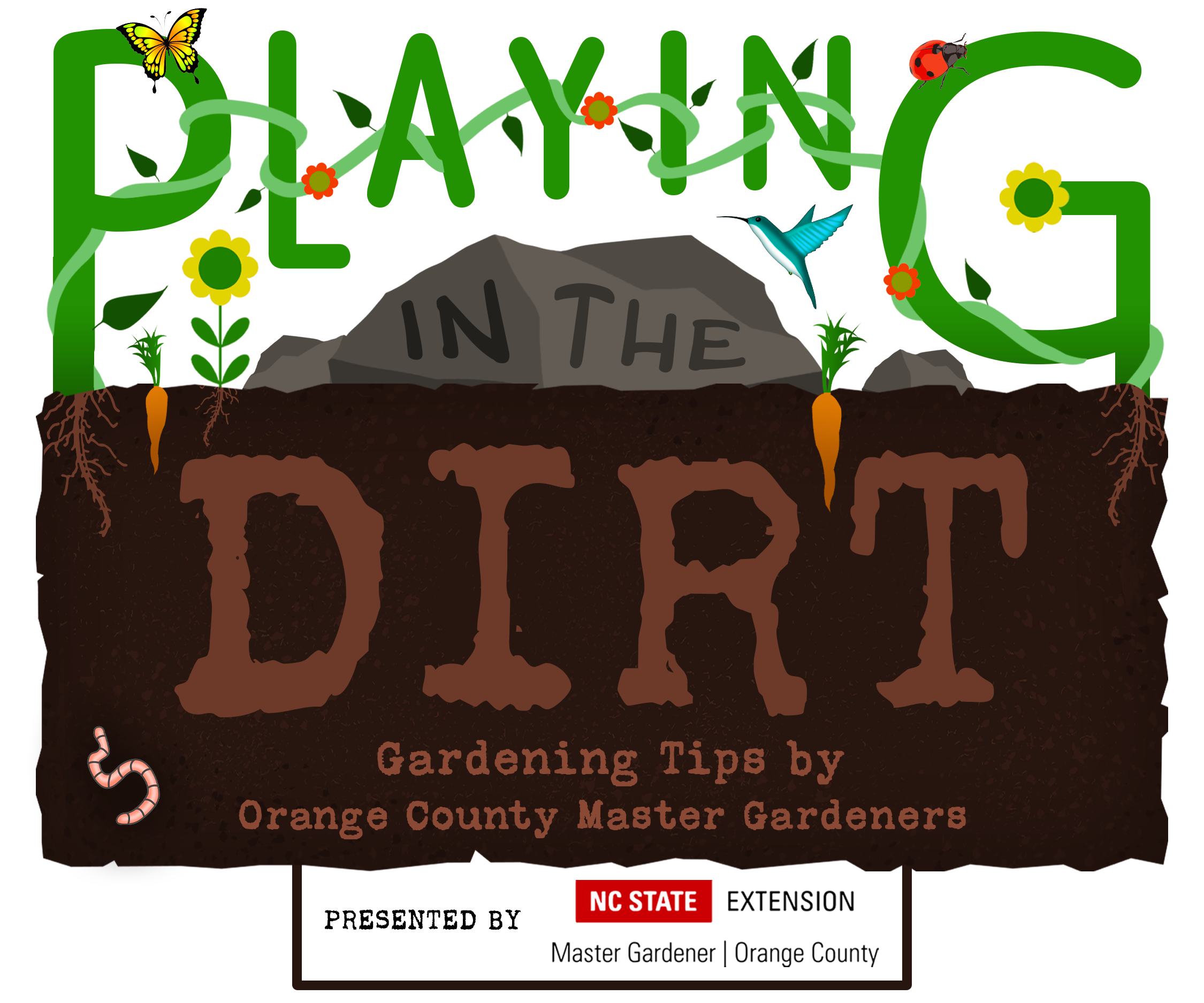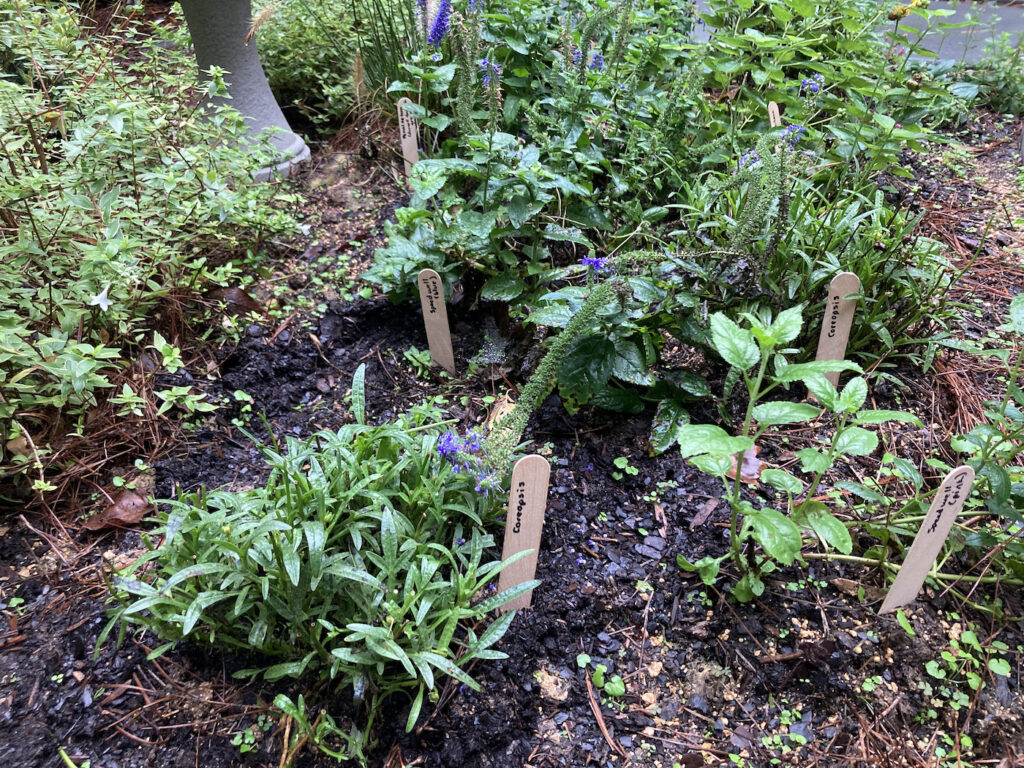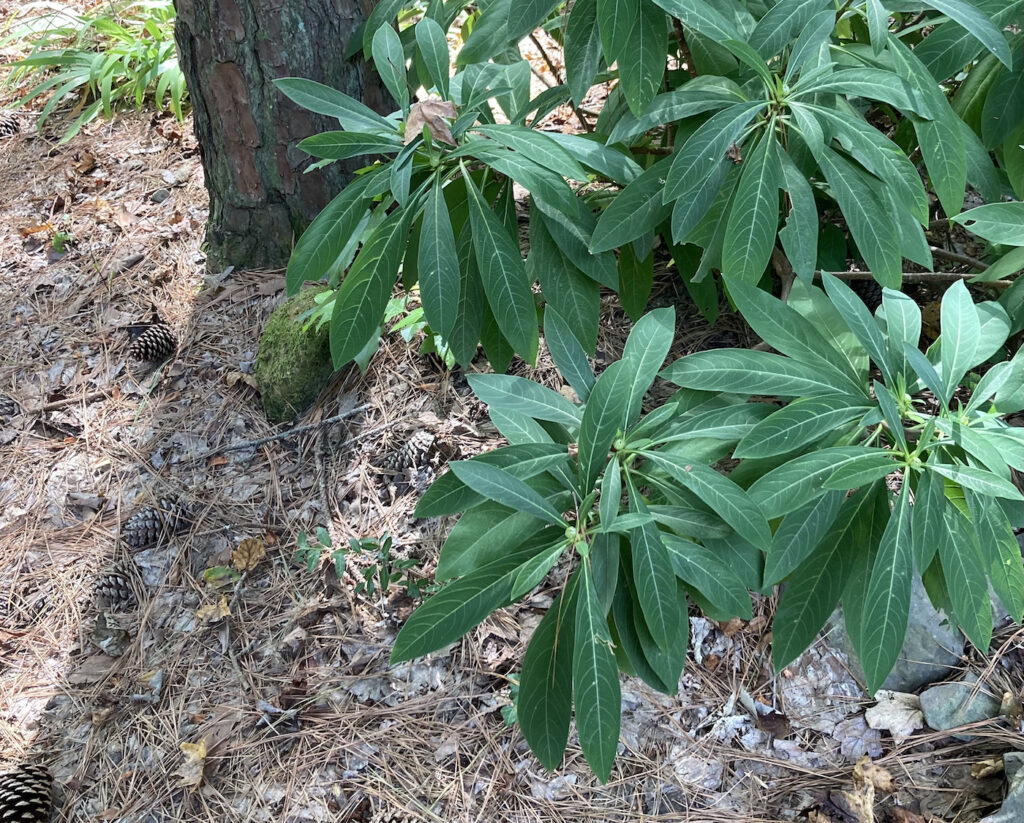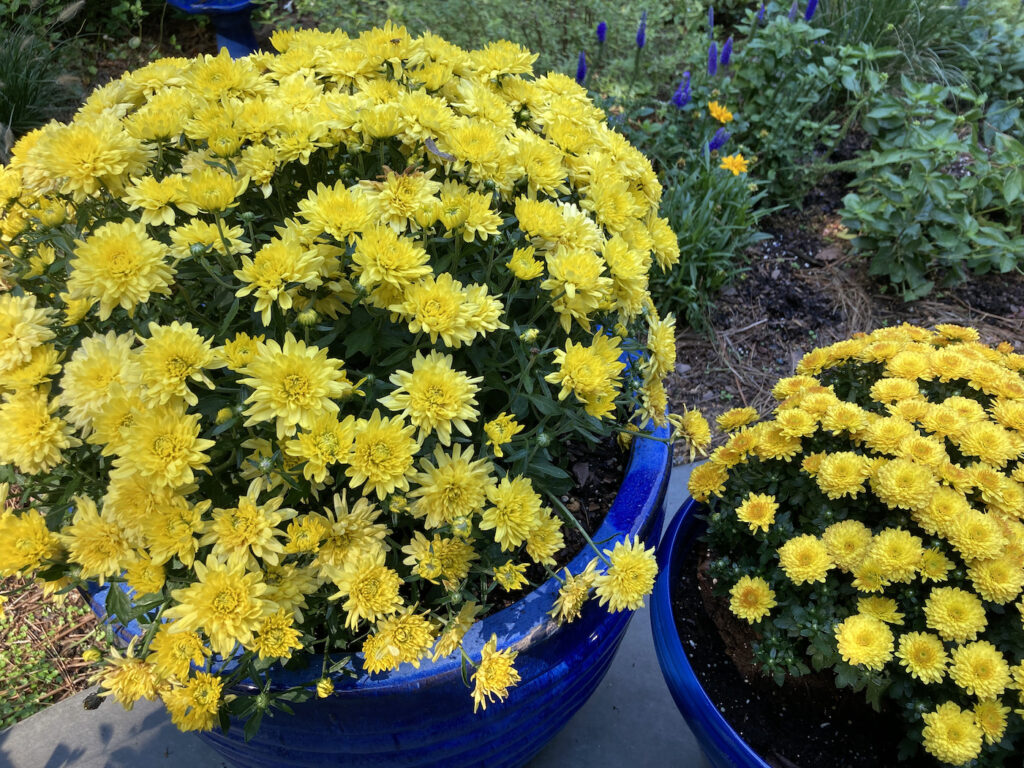
97.9 The Hill and Chapelboro.com have partnered with Orange County Master Gardeners for “Playing in the Dirt,” a monthly column exploring the fertile ground of home gardening in our community and intended to provide the information and inspiration gardeners of all skills levels need to flourish! Check back on Chapelboro each month for a new subject – from our gardens to yours!
By Margaret Alford Cloud, Orange County Master Gardener Volunteer
The cool, sunny days of fall are perfect for gardening. It’s a good time to plant new shrubs or trees, prepare the garden for winter and organize and rethink your garden spaces. While it’s never hard to find things to do in your garden and yard, here are autumn suggestions, including (yay!) some tasks that you can skip!
Mark Your Plants

Use wood sticks or metal markers to mark the locations of your perennials. (Photo by Margaret Alford Cloud)
Before perennial flowers go dormant for the winter, mark their locations with wooden sticks or metal markers. Mark the locations of bulbs, too. Knowing plant locations will help in early spring, when you may want to dig in the garden before plants have sprouted. The markers are available from nurseries and hardware stores or you can make your own.
Before you remove dead annual flowers or vegetable plants this fall, make a diagram of their locations. Next year, use the map to plant vegetables or annuals in different spots. Pests and diseases can remain in the soil after dead plants are removed. Changing the locations of plant families breaks the life cycle of diseases and pests and helps keep soil nutrients balanced. For example, eggplants, peppers, potatoes and tomatoes are all in the nightshade family and can attract similar pests and diseases so their locations in the garden need to be rotated with other plant families.
Plant Shrubs or Trees
Late fall is a good time to plant shrubs and trees. With plenty of moisture and cool temperatures, roots have a chance to grow and establish over the winter.
When possible, select varieties that are native (plants that developed naturally in our region). They have adapted to our soil and weather conditions and will thrive without a lot of extra care. They can provide food, shelter and habitats for birds, pollinators and other beneficial insects and wildlife. Choose plants that bloom at different seasons. Avoid planting invasive trees and shrubs; some non-native species are aggressive spreaders that can threaten a local ecosystem. Examples of invasives in North Carolina include Bradford pears and Chinese privets.
Consider the plant’s light, moisture and soil needs as well as its full-grown size. If you live in an area where deer roam, look for plants that are not attractive to deer.

A planting hole for a tree should be twice the diameter of the root ball and no deeper than the root ball. (From chatham.ces.ncsu.edu)
When you’re ready to plant, prepare an entire planting bed instead of a single hole. Mix 1 to 3 inches of organic matter into the top 12 inches of soil. The hole for a tree or shrub should be twice the size of the plant’s root ball, with gently sloping sides. The crown of the plant should sit just above the ground after the hole is filled. Add mulch on top of the soil but keep the mulch about 6 inches away from the trunk. Learn more about planting here.
Plant Bulbs
Buy bulbs now when the selection is best but wait to plant them when nighttime temperatures stay below 60 degrees (usually mid-November to early December in our area). Read more about bulbs in a recent Playing in the Dirt column.
Keep Some Leaves and Flower Heads
Many people think of fall as a time to clean up the yard; they want to rake all the leaves and remove dead or dormant plant stalks. But it’s helpful to leave some leaves and other dead plant materials in place over the winter.
Remove dead vegetable plants from the garden because they can harbor diseases or harmful insects. But don’t trim other plants right away.

Flower pods of black-eyed Susans (left) and bee balm (right) can be left in place over the winter to help birds and insects. (Photo by Margaret Alford Cloud)
Leave some flower heads on dormant plants to provide food for birds and insects. Wait until late winter or early spring to cut back the dead stems.
Remove leaves from grassy areas so that the leaves don’t suffocate the grass. But in wooded parts of the yard, leave the leaves on the ground. It’s a win-win: less work for you and a benefit for plants and wildlife.

Leaf litter on the ground provides natural mulch and habitat for insects and animals. This paper bush (Edgeworthia chrysantha) has thrived with a blanket of leaves left at its base. (Photo by Margaret Alford Cloud)
The fallen leaves provide a blanket of mulch that protects plant and tree roots in cold or dry weather. The leaves also provide a home for insects and other creatures, including some that are food sources for birds and other animals. As the leaves break down, they provide organic nutrients for the soil.
When you do rake leaves, save them in a mulch or compost pile. An easy way to collect leaves from grass is to use a mower with a bag attachment — the mower usually shreds the leaves, helping them decompose more quickly. Weed-free leaves are a common source of carbon-rich “brown” material for backyard composting.
Take Care of Soil
When preparing your garden for the winter, don’t leave any soil uncovered. Protect bare soil from erosion and loss of nutrients by adding a layer of organic mulch or planting a cover crop. A crop such as crimson clover can be grown over the winter and turned under in spring to add nitrogen to the soil.
Get a soil test to check acidity and nutrient levels. It’s free through November! Soil test boxes are available at the N.C. Cooperative Extension office at 1020 US 70 West, Suite 130, Hillsborough, NC 27278 (across from the DMV driver’s license office). Read more about soil in a recent Playing in the Dirt column.
Clean Tools
If you aren’t planning to use garden tools for a while, clean them well and dry them before storing them for the winter. Clean tools last longer and work better. Read more here.
Sign Up for a Class
When it is too cold or wet to garden in winter, you might want to try a class or activity offered by area gardens. Many are online.
- The North Carolina Botanical Garden (Chapel Hill) has classes for adults and youth. You can sign up for in-person or online classes. You can also watch, for free, recordings of past NCBG webinars on garden and nature topics.
- Duke Gardens (Durham) also has classes for adults and youth, including options for at-home learning. At the Charlotte Brody Discovery Garden, children and adults can learn about organic gardening and ecological practices.
- The Raulston Arboretum (Raleigh) offers classes and educational activities for adults and children. The children’s offerings include monthly garden activity kits which can be picked up at the arboretum or shipped to the home.
Additional Resources
- North Carolina Extension Gardener Handbook (North Carolina State University Extension Publications):
- Leave the leaves (North Carolina Cooperative Extension, Richmond County Center).
- Have a plant or garden question for the Orange County Master Gardeners? Emailocmgardeners@gmail.com or phone 919-245-2061. Find plant information at The Orange Gardener and follow us on Facebook (search for OCEMGV).
- Read earlier Playing in the Dirt columns here.
Chapelboro.com does not charge subscription fees. You can support local journalism and our mission to serve the community. Contribute today – every single dollar matters.


